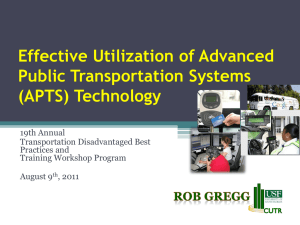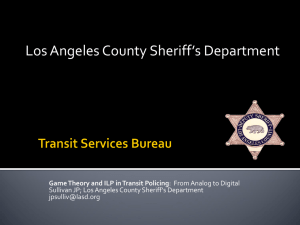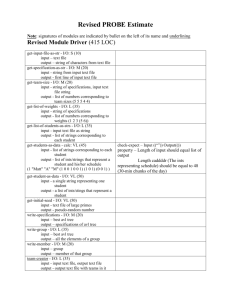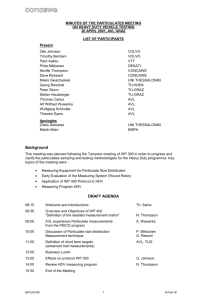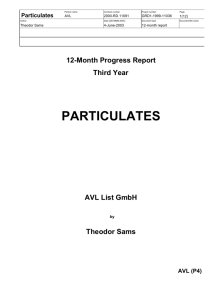CTD Annual 2013fin - Florida Department of Transportation
advertisement
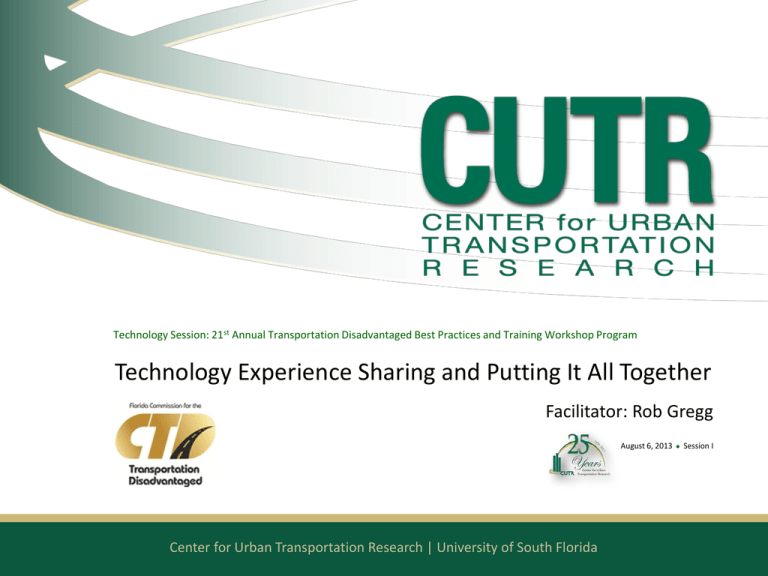
Technology Session: 21st Annual Transportation Disadvantaged Best Practices and Training Workshop Program Technology Experience Sharing and Putting It All Together Facilitator: Rob Gregg August 6, 2013 Center for Urban Transportation Research | University of South Florida l Session I Mobility + Technology = Better Application of advanced and emerging technologies in information processing, communications, control, and electronics to meet public transportation needs 21st Annual Transportation Disadvantaged Best Practices and Training Workshop Program August 6th, 2013 Why Technology? – Customer: Traveler information, more convenient routes, schedules, access – Efficiency / Productivity: Lower costs, operations, maintenance, improved response / travel times – Optimize System Management: Planning, monitoring, operator assistance, administrative processes – Safety & Security: Controls, surveillance, communication, emergencies Technology Session: 21st Annual Transportation Disadvantaged Best Practices and Training Workshop Program Veterans Transportation and Community Living Initiatives Grant Twelve Florida Sites Awarded 2011- 2012 Technology Session: 21st Annual Transportation Disadvantaged Best Practices and Training Workshop Program Ms. Gwen Johnson Program Supervisor Polk County Transit Services/ Polk Transit and Ms. Dean Kirkland-McMillan Director of Safety Security & Operations Support Citrus Connection/ Polk Transit Technology Session: 21st Annual Transportation Disadvantaged Best Practices and Training Workshop Program Liz Peak Regional Services Coordinator Jacksonville Transportation Authority Technology Session: 21st Annual Transportation Disadvantaged Best Practices and Training Workshop Program Mr. Hugh Chen Deputy Director of Operations, Miami-Dade Transit Technology Session: 21st Annual Transportation Disadvantaged Best Practices and Training Workshop Program Types of APTS 1. 2. 3. 4. 5. 6. 7. Communication Systems Operational Software (e.g. Scheduling) Advanced Traveler Information Systems (ATIS) Electronic Fare Payment (EFP) Computer-aided Dispatch (CAD) Automatic Vehicle Location (AVL) Mobile Data Terminals (MDTs) or Mobile Data Computers (MDCs) 8. Automatic Passenger Counters (APC) 9. Surveillance and Security Equipment 10. Coordination and Integration Software Advanced Traveler Information Systems (ATIS) • Includes: internet websites, automated telephone systems, audible enunciators, kiosks, transit stops with automated information, trip planners, smart phone apps • May be static or real-time • Schedules, fares, routes, transfers, arrival time, and availability of special equipment • Available on vehicle, at stop, on the internet, phone, or mobile phone Advanced Traveler Information Systems Electronic Fare Payment • Pay electronically using a magnetic stripe card or smart card • Coordinated billing and invoicing between human services agencies and transit providers Electronic Fare Payment Computer-Aided Dispatch (CAD) CAD is used to assist agencies in dispatching paratransit / flex-routing vehicles and is typically integrated with AVL and other information management technologies, such as scheduling and routing software Automatic Vehicle Location (AVL) • Using a positioning system, such as the global positioning systems (GPS), and a Geographic Information System (GIS) the operating agency can track its buses • Combining AVL with ATIS, the agency can alert riders with realtime information • Combining AVL with CAD, the agency can reroute vehicles to provide flexible service CAD/AVL Mobile Data Terminal/Computer • An MDT/MDC is a small on-board computer and interface that links the driver to an agency’s computer network through wireless communications Mobile Data Terminal/Computer Automatic Passenger Counters (APC) • An APC system provides a transit system with an automated method for collecting information about the number of passenger boardings and alightings at a variety of system levels, including route, route segment, or specific bus stops by time of day and by day of week. • Can be integrated into AVL systems Automatic Passenger Counters (APC) Surveillance and Security Equipment • Safety and security technologies include video surveillance cameras, silent alarms and covert microphones on vehicles, and “smart” cards for driver identification. • Surveillance and security systems can be provided in transit vehicles and at transit stops and stations. Surveillance and Security Equipment Coordination/Integration Software • This technology helps agencies with scheduling, routing, billing, and reporting. • Typical applications include: – coordinating paratransit routes and schedules within a single agency or among multiple agencies – coordinating fare card usage and billing among multiple agencies – integrating software systems across multimodal transit systems Coordination/Integration Software APTS Success Steps / Cycle Business Objectives Technology Assessment System Engineering • Stakeholders • Survey • Operations Implementation Test - Operate • Functional Specs • Customer: Functional Areas • Efficiency: •Legacy Systems • Performance: • Needs •Training & Support •Training •Benefits •Test •Operating •Manufacturing •Maintaining •Implementation •Data Management • Service: • Safety: • Priorities •Conceptual • Cost & Schedule •Performance process Plans Use the Data! • Procurement •Testing Rob Gregg Director Transit Management & Innovation Center for Urban Transportation Research (CUTR) University of South Florida 4202 E. Fowler Avenue Tampa, Florida 33620-5375 Phone: (813) 974-8383 Fax: (813) 974-5168 "It's a beautiful day, don't let it get away"
